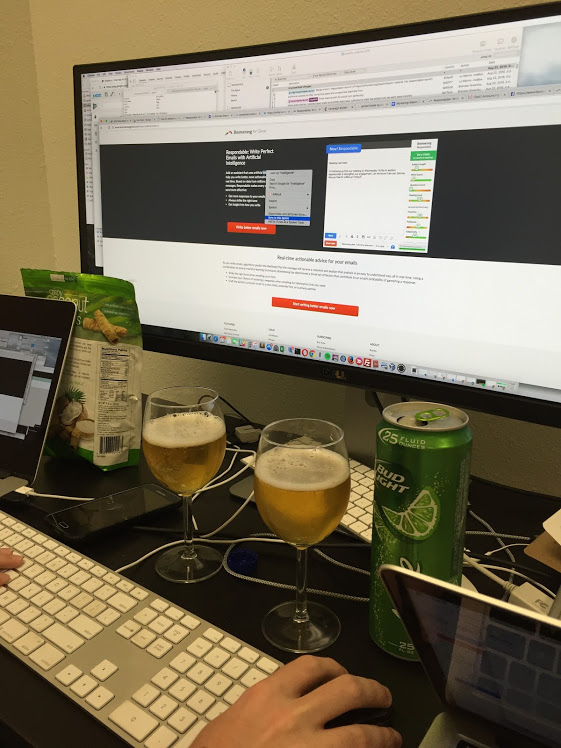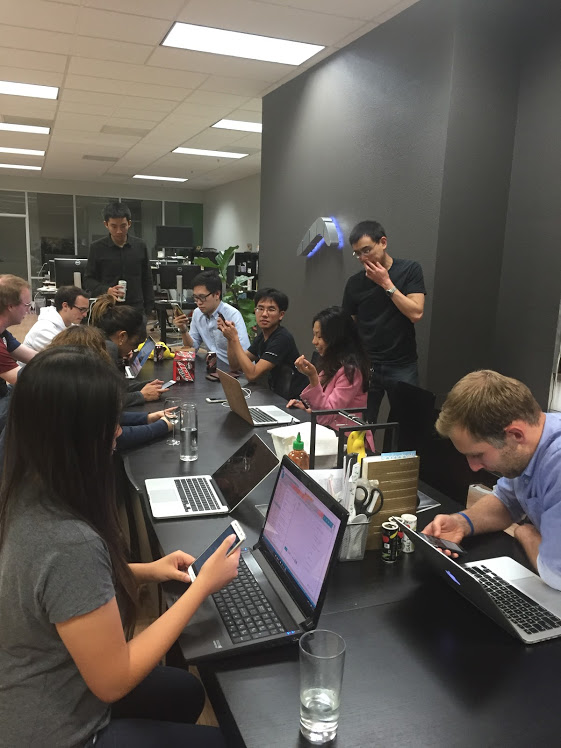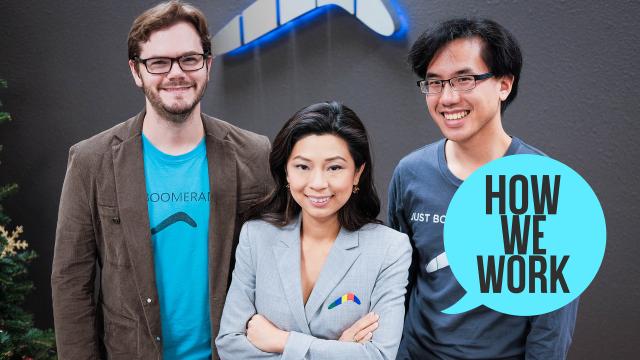Boomerang lets you schedule your email. That essential feature is the core of Boomerang’s growing number of apps, add-ons, and features, which fill in the many gaps of popular email services like Gmail.
Four years ago we interviewed one of Boomerang’s founders about building Boomerang. Now we’ve talked to all three co-founders about how they run the company, build their technology, and get their work done.
Location: Mountain View, CA
Current gig:
Alex Moore: CEO
Aye Moah: Chief of Product
Mike Chin: CTO
One word that best describes how you work:
Alex: “Bursty”
Aye: Binary
Mike: Whatever the opposite of procrastinate is
Current mobile device:
Alex: iPhone 6
Aye: iPhone 7
Mike: iPhone X
Current computer:
Alex: Surface Pro. I spend a lot of time reviewing and editing things these days. When I can disconnect my computer and have it turn into a tablet, with a pen, and with all my apps and data still right there, it makes me a lot more effective.
Aye: 13inch MacBook Air
Mike: Sager NP8157 (Clevo P650HS-G)
First of all, tell us a little about your background and how you got to where you are today.
Alex: After growing up in Alabama, I studied electrical engineering and computer science at MIT. When I graduated, there were two jobs I was really excited about: working at Microsoft as a Product Manager on the Outlook team, or working at Analogue Devices as a Product Engineer. I picked the analogue circuits route. After a few years of work, personally spending a lot of time struggling with email and collaboration, I realised I was meant to be working on those problems. So we started Boomerang, and seven years later, we’re still making cool productivity apps, but profitably now!
My role has changed a lot as we’ve grown from just the three of us, Aye Moah, Mike Chin and myself, to over 20, which helps keep things fresh. The first year, I spent most of my time writing code to build the core product. Once we converted Boomerang to a paid service, I split my time between marketing to new customers, supporting existing ones, and building new features. Now, I mostly enable my teammates to do great work, interface with our big customers and partners, and recruit great team members. I still get to write a little bit of code, usually working on internal features or experimental projects.
Aye: I was born and raised in Yangon, Myanmar until I moved to the US to study Computer Science at MIT. I went into tech consulting for a couple years to find out which part of the software creation process that I really love. That led me to move into UX Design and Product Management. I went from giant software companies to smaller and smaller companies until I co-founded Boomerang with Alex & Mike.
Mike: I grew up in Connecticut and went to Dartmouth College. I thought I would study Classics (I took Latin and Ancient Greek in high school) and even explored a little bit of Cognitive Science (taking classes in both psychology and linguistics), but ultimately I majored in Computer Science and minored in Mathematics. After college, I joined Alex and Moah in Boston to co-found Boomerang. I’ve never worked anywhere else other than my own startup! I moved to the San Francisco Bay Area in 2011.
Take us through a recent workday.
Alex: My favourite workdays are Wednesdays, because we block off Wednesday afternoon as “maker time” for the entire company. We don’t have meetings and turn off chat/IM so we can work on projects that require sustained focus. For me, I often get to write code.
We start work late, so last Wednesday I woke up with my son around 8am. I spent the first hour playing and reading books with him, getting him dressed and ready for the day, and making breakfast. After a quick shower, I walked to work. After arriving at the office and having our daily standup, I had two phone calls, then spent an hour catching up on email.
After lunch, I worked on prototyping a new machine learning model for Respondable (our tool that uses machine learning to help you write more effective emails) for most of the afternoon. Then I checked in with a couple folks from our team and wrapped up the day with another batch of email before making the walk home.

Launching Boomerang Respondable
Aye: I try to reserve half of my workday for deep work where I am designing a feature or planning a future project or analysing some data while spending the other half on doing design reviews, editing and approving various marketing materials, and doing product sign-offs for the development team.
The nature of my role requires me to be responsive to different teams at different urgency levels, so every day is different for me. On top of that, I really hate rigid routines. My schedule ends up looking pretty random most of the time.
Today after our daily standup, I went straight into a product sign-off with one of the dev teams. After that, I did email and answered people’s questions for both product and non-product related items. I spent the afternoon creating an interview process for a new Senior Product Manager position that we’re hiring. (Then I worked on this interview.)
Mike: My schedule is pretty consistent! Every day, I wake up a few minutes before my 9:37am alarm, take a shower, and walk to work. I enjoy walking; I let my mind wander. After a 10:30am daily standup meeting (where our 19-person team stands in a circle to share what we’re working on and what help we need), I jump into email, review code, and help my co-workers with the projects that they mentioned at standup.
In the afternoon, I’m often meeting with the support, product, or engineering teams to figure things out and prioritise what new features to build. Or, if no meetings are planned, I’ll be at my computer, headphones plugged in, writing code for those new features. On Fridays, I like having one-on-one walking meetings with my co-workers to check in.
What apps, gadgets, or tools can’t you live without?
Alex: I used to live in Vim, and it’s still an everyday app for me. I also rely heavily on Gmail (with Boomerang, of course!), Feedly, Wunderlist, Evernote, Excel, and a rotating cycle of full-screen writing apps.
Aye:
- Gmail with Boomerang
- Alfred: I just got a new computer and haven’t installed it because I haven’t found the licence key. Now I’m suffering every time I have to copy more than one thing.
- Kindle: I read every night in my quest to read 50 books a year.
- Goodreads
Mike:
- Kindle
- Gmail
- Slickdeals
- Vanguard
- Sublime Text 2, with vim commands
- foobar2000, for playing music
What’s your workspace setup like?
Alex: The centrepiece is a 34inch curved monitor. It’s one of the best investments I’ve made, because I can have 3 – 4 windows open at a time in a functional way. It makes pulling together data for an investor update a snap, or I can open up an editor, an API document, and a test browser all at once.

Members of the Boomerang team
Besides the monitor, I have a standing desk, a set of Bluetooth noise cancelling headphones, a paper pad, a set of multicolored pens, and a 20-minute hourglass.
Aye: I have a 30inch monitor, Kinesis Freestyle2 split keyboard (this keyboard saved me from Carpal Tunnel), a simple footstool mandated by my physical therapist (short people problems), and a MultiTable convertible standing desk with Topo anti-fatigue mat when I stand.
Mike:
- Two Dell Ultrasharp monitors
- Das Mechanical Keyboard
- Etymotic earphones for noise isolation
- Logitech Performance MX Mouse
What’s your best time-saving shortcut or life hack?
Alex: Limiting interruptions while I’m working.
I use Boomerang’s Inbox Pause feature (sorry for the self-promotion) to only allow email to arrive in my inbox 4 times a day — and never first thing in the morning.
We also have a company policy that Slack is set to Do-Not-Disturb mode by default during work hours. When we made that change, Slack messages across the company dropped 35%, and the amount of code that we wrote increased 35% across all of our engineering teams. Our brains really aren’t wired to be interrupted constantly. So it makes a huge difference.
Mike: I think in terms of energy rather than time. So my life hack is to get enough sleep. My day is both more productive and more enjoyable when I’m well-rested or manage to sneak in a nap. I’ll gladly trade time for being able to spend less mental energy.
Who are the people who help you get things done, and how do you rely on them?
Alex: I was lucky enough to find cofounders who were very complementary. At first, when we were all mostly focused on building the product, we specialised in different areas. I’m good at starting things and so-so at finishing them. Moah was good at taking the seed of something and turning it into a real something.
And Mike was fantastic at taking that something and getting it production-ready. Usually, if I’m stuck or if there’s something I’m not making much progress on, one of them can take the baton, move things forward, and then hand it back off to me.
Aye: My co-founder, Alex, and my co-worker, Mai-chi. They help me get things done by being a sounding board when I’m stuck. I rely on Alex to help prioritise whenever I am spinning.
How do you keep track of what you have to do?
Aye: I split them into three piles. The first pile is for things that are time-sensitive but not appointments. For those, I use Boomerang to remind myself everything I need to do at the time I need.
The second pile is for things that are not time-sensitive. It’s a running list of things that should happen at some point. I used to put everything on Wunderlist but now that it’s going away, I have been transitioning to Google Keep. I also have Bullet Journal for my notes from meetings and more nuanced project related to-dos and future ideas.
The third pile is meetings and appointments. As soon as a meeting, a call, or an appointment is confirmed (which usually happens over email), I make sure to get that into my calendar right away with Boomerang Calendar extension. I only use one calendar for both personal and work appointments because I like seeing what’s on tap for the day in one place.
Mike: I use Boomerang, Google Keep, and Google Calendar to tell my future self what to do. The less stuff I need to keep in my head, the better.
What’s your least favourite thing to do, and how do you deal with it?
Alex: I hate any kind of manual, repetitive computer work. It literally makes my head ache. If I have more than 15-20 minutes of it to do, I’ll often end up throwing together a script (check out Project Sikuli, which lets you write simple scripts that use computer vision to click things for you) to at least do part of it for me.
When it doesn’t make sense to automate it, I try to work in 20 minute blocks with a break in between. Every work session, I put on music, get a fresh piece of chewing gum, change from sitting to standing or vice versa, and turn over my hourglass.
Aye: My least favourite thing to do is keeping track of conversations that happen on Slack while I’m away from my desk. I haven’t found a way to deal with it so far. I am looking for a way to get an AI tool to summarise conversations and alerting me of things I need to get back to.
Mike: The idea of being late or having to cram for a deadline terrifies me, so I’ll do whatever it takes to get the hard or mentally-exhausting tasks done at the beginning. That way, I can relax at the end.
How do you recharge? What do you do when you want to forget about work?
Alex: These days I mostly recharge through cooking. It’s creative, but it’s hands-on, kind of meditative, and at the end, you can feed your family something great.
Aye: During the week, I read something fun that doesn’t require too much thinking to escape from work like Six of Crows. During the weekends, I go hiking with my family.
Mike: I like video games. If work feels chaotic, I’ll pick a slower-paced game like Stardew Valley where decisions are rewarded predictably and linearly. If work is quiet, I’ll play an action game like Splatoon.
What’s your favourite side project?
Alex: For the past 20 months, the only side project I’ve had time for is playing with my son 🙂 Before that, I worked on a site, Taxbreakdown.org [currently down — Ed.], that provided a personalised look at how the Federal Government spends the taxes you pay. I’m still hoping someone will crack that nut — the average American thinks 31% of the Federal Budget is spent on foreign aid, but it’s really less than 1%!
Aye: I volunteer with an organisation called Build a School in Burma as an advisory board member. We build schools in underserved communities in Burma and so far have built 30 schools.
Mike: I’m not working on anything at the moment, but in the past I’ve participated in National Novel Writing Month (my book Time Travel 101 is in the Kindle store!) and learned guitar through Rocksmith.
What are you currently reading, or what’s something you’d recommend?
Aye: I just finished reading 80,000 Hours. It’s a framework for helping on how best to choose a career with high social impact. I read it as a book but all the content is free on their website.
I think it’s a great way to think about what you do in the context of what impact you can have while still doing what you love. I highly recommend it to everyone who cares about how they spend their time, basically if you’re a Lifehacker reader, you probably already think about your career in this way. I believe one of the best life hacks is choosing the right job that makes you feel fulfilled every day.
Mike: I’m rereading the Wheel of Time series by Robert Jordan. It’s the longest series I’ve ever read (14 books), and it’s easily my favourite.
Fill in the blank: I’d love to see _________ answer these same questions.
Alex: Ezra Klein and Brandon Sanderson.
Aye: J. K. Rowling.
What’s the best advice you’ve ever received?
Alex: Spend at least as much time playing to your strengths as working on your weaknesses.
Aye: “Focus on the process, not the results.” When you focus on things you control and do your best every day, the results will follow. It’s especially relevant to startup founders because you want to have the discipline to keep working hard on things you control with your own team. It saves you from wasting time focusing on competitors or other factors that are outside of your control.
Mike: I have no idea where it came from, but the phrase “don’t eat the second doughnut” is a line that I keep coming back to. It’s either an insightful statement about willpower and exercising self-control, or it’s something my mum said to me once when my brain was developing memory function, I guess.
Is there anything else you’d like to add that might be interesting to readers and fans?
Mike: Send feedback to us; we read and respond to every email.
This interview has been lightly edited and some links have been added.
The How I Work series asks heroes, experts, and flat-out productive people to share their shortcuts, workspaces, routines, and more. Have someone you want to see featured, or questions you think we should ask? Email Nick.

Comments